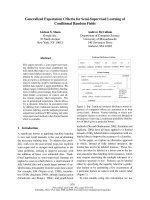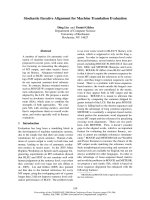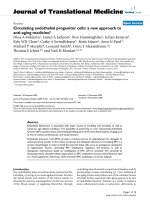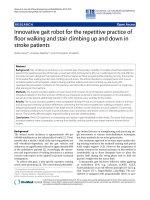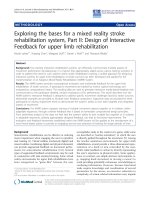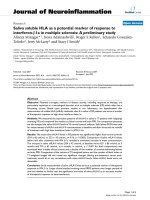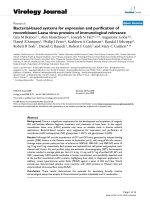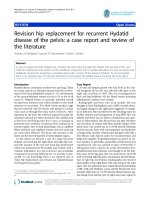Báo cáo hóa học: "PROJECTION ITERATIVE APPROXIMATIONS FOR A NEW CLASS OF GENERAL RANDOM IMPLICIT QUASI-VARIATIONAL INEQUALITIES" pdf
Bạn đang xem bản rút gọn của tài liệu. Xem và tải ngay bản đầy đủ của tài liệu tại đây (598.15 KB, 17 trang )
PROJECTION ITERATIVE APPROXIMATIONS FOR
A NEW CLASS OF GENERAL RANDOM IMPLICIT
QUASI-VARIATIONAL INEQUALITIES
HENG-YOU LAN
Received 9 November 2005; Accepted 21 January 2006
We introduce a class of projection-contraction methods for solving a class of general
random implicit quasi-variational inequalities with random multivalued mapping s in
Hilbert spaces, construct some random iterative algorithms, and give some existence the-
orems of random solutions for this class of general random implicit quasi-variational
inequalities. We also discuss t he convergence and stability of a new perturbed Ishikawa
iterative algorithm for solving a class of generalized random nonlinear implicit quasi-
variational inequalities involving random single-valued mappings. The results presented
in this paper improve and extend the earlier and recent results.
Copyright © 2006 Heng-You Lan. This is an open access article distributed under the
Creative Commons Attribution License, which permits unrestricted use, distribution,
and reproduction in any medium, provided the original work is properly cited.
1. Introduction
Throughout this paper, we suppose that
R denotes the set of real numbers and (Ω,Ꮽ,μ)
is a complete σ-finite measure space. Let E be a separable real Hilbert space endowed with
the norm
·and inner product ·,·,letD be a nonempty subset of E,andletCB(E)
denote the family of all nonempty bounded closed subsets of E. We denote by Ꮾ(E)the
class of Borel σ-fields in E.
In this paper, we will consider the following new general random implicit quasi-
variational inequality with random multivalued mappings by using a new class of pro-
jection method: find x : Ω
→ D and u, v,ξ : Ω → E such that g(t,x(t)) ∈ J(t,v(t)), u(t) ∈
T(t,x(t)), v(t) ∈ F(t, x(t)), ξ(t) ∈ S(t,x(t)), and
a
t,u(t),g(t, y) − g
t,x(t)
+
N
t, f
t,x(t)
,ξ(t)
,g(t, y) − g
t,x(t)
≥
0 (1.1)
for all t
∈ Ω and g(t, y) ∈ J(t,v(t)), where g : Ω × D → E, f : Ω × E → E,andN : Ω × E ×
E → E are measurable single-valued mappings, T, S : Ω × D → CB(E)andF : Ω × D →
CB(D) are random multivalued mappings, J : Ω × D → P(E) is a random multivalued
Hindawi Publishing Corpor ation
Journal of Inequalities and Applications
Volume 2006, Article ID 81261, Pages 1–17
DOI 10.1155/JIA/2006/81261
2 Projection iterative approximations
mapping such that for each t
∈ Ω and x ∈ D, P(E) denotes the power set of E, J(t, x)is
closed convex, and a : Ω
× E × E → R is a random function.
Some special cases of the problem (1.1) are presented as follows.
If g
≡ I, the identity mapping, then the problem (1.1)isequivalenttotheproblemof
finding x : Ω
→ D and u,v,ξ : Ω → E such that x(t) ∈ J(t,v(t)), v(t) ∈ F(t,x(t)), u(t) ∈
T(t,x(t)), ξ(t) ∈ S(t,x(t)), and
a
t,u(t), y − x(t)
+
N
t, f
t,x(t)
,ξ(t)
, y − x(t)
≥
0 (1.2)
for all t
∈ Ω and y ∈ J(t,v(t)). The problem (1.2)iscalledageneralizedrandomstrongly
nonlinear multivalued implicit quasi-variational inequality problem and appears to be a
new one.
If J(t,x(t))
= m(t,x(t)) + K,wherem : Ω × D → E and K is a nonempty closed con-
vex subset of E, then the problem (1.1) becomes to the following generalized nonlin-
ear random implicit quasi-variational inequality for random multivalued mappings: find
x : Ω
→ D and u,v,ξ : Ω → E such that g(t,x(t)) − m(t,v(t)) ∈ K, u(t) ∈ T(t,x(t)), v(t) ∈
F(t,x(t)), ξ(t) ∈ S(t,x(t)), and
a
t,u(t),g(t, y) − g
t,x(t)
+
N
t, f
t,x(t)
,ξ(t)
,g(t, y) − g
t,x(t)
≥
0 (1.3)
for all t
∈ Ω and g(t, y) ∈ m(t,v(t)) + K.
If N(t,z,w)
= w + z for all t ∈ Ω, z,w ∈ E, then the problem (1.1) reduces to find-
ing x : Ω
→ D and u,v, ξ : Ω → E such that g(t,x(t)) ∈ J(t,v(t)), u(t) ∈ T(t,x(t)), v(t) ∈
F(t,x(t)), ξ(t) ∈ S(t,x(t)), and
a
t,u(t),g(t, y) − g
t,x(t)
+
f
t,x(t)
+ ξ(t), g(t, y) − g
t,x(t)
≥
0 (1.4)
for all t
∈ Ω and g(t, y) ∈ J(t,v(t)).
The problem (1.4) is called a generalized random implicit quasi-variational inequality
for random multivalued mappings, which is studied by Cho et al. [8]whenT
≡ I and
f
≡ 0, and includes various known random variational inequalities. For details, we refer
the reader to [8, 11, 12, 19] and the references therein.
If T,S : Ω
× D → E and F : Ω × D → D are random single-valued mappings, and F = I,
then the problem (1.4) becomes to the following random generalized nonlinear implicit
quasi-variational inequality problem involving random single-valued mappings: find x :
Ω
→ D such that g(t,x(t)) ∈ J(t,x(t)) and
a
t,T
t,x(t)
,g(t, y) − g
t,x(t)
+
f
t,x(t)
+ S
t,x(t)
,g(t, y) − g
t,x(t)
≥
0
(1.5)
for all t
∈ Ω and g(t, y) ∈ J(t,x(t)).
Remark 1.1. Obviously, the problem (1.1) includes a number of classes of variational in-
equalities, complementarity problems, and quasi-variational inequalities as special cases
(see, e.g., [1, 4, 5, 8, 10–13, 15, 17, 19, 20, 25] and the references therein).
Heng-You Lan 3
The study of such types of problems is inspired and motivated by an increasing interest
in the nonlinear random equations involving the random operators in view of their need
in dealing with probabilistic models, which arise in biological, physical, and system sci-
ences and other applied sciences, and can be solved with the use of variational inequalities
(see [21]). Some related works, we refer to [2, 4] and the references therein. Further, the
recent research works of these fascinating areas have been acce lerating the random v ari-
ational and random quasi-variational inequality problems to be introduced and studied
by Chang [4], Chang and Zhu [7],Choetal.[8], Ganguly and Wadhwa [11], Huang [14],
Huang and Cho [15], Huang et al. [16], Noor and Elsanousi [19], and Yuan et al. [24].
On the other hand, in [22], Verma studied an extension of the projection-contraction
method, which generalizes the existing projection-contraction methods, and applied the
extended projection-contraction method to the solvability of a general monotone varia-
tional inequalities. Very recently, Lan et al. [17, 18] introduced and studied some new iter-
ative algorithms for solving a class of nonlinear variational inequalities with multivalued
mappings in Hilbert spaces, and gave some convergence analysis of iterative sequences
generated by the algorithms.
In this paper, we introduce a class of projection-contraction methods for solving a new
class of gener al random implicit quasi-variational inequalities with random multivalued
mappings in Hilbert spaces, construct some random iterative algorithms, and give some
existence theorems of random solutions for this class of general random implicit quasi-
variational inequalities. We also discuss the convergence and stability of a new perturbed
Ishikawa iterative algorithm for solving a class of generalized random nonlinear implicit
quasi-variational inequalities involving random single-valued mappings. Our results im-
prove and generalize many known corresponding results in the literature.
2. Preliminaries
In the sequel, we first give the following concepts and lemmas which are essential for this
paper.
Definit ion 2.1. Amappingx : Ω
→ E is said to be measurable if for any B ∈ Ꮾ(E), {t ∈
Ω : x(t) ∈ B}∈Ꮽ.
Definit ion 2.2. AmappingF : Ω
× E → E is said to be
(i) a random operator if for any x
∈ E, F(t,x) = y(t) is measurable;
(ii) Lipschitz continuous (resp., monotone, linear, bounded) if for any t
∈ Ω,the
mapping F(t,
·):E → E is Lipschitz continuous (resp., monotone, linear, bound-
ed).
Definit ion 2.3. AmultivaluedmappingΓ : Ω
→ P(E) is said to be measurable if for any
B
∈ Ꮾ(E), Γ
−1
(B) ={t ∈ Ω : Γ(t) ∩ B = ∅}∈Ꮽ.
Definit ion 2.4. Amappingu : Ω
→ E is called a measur able selection of a multivalued
measurable mapping Γ : Ω
→ P(E)ifu is measurable and for any t ∈ Ω, u(t) ∈ Γ(t).
Definit ion 2.5. Let D be a nonempty subset of a separable real Hilbert space E,letg :
Ω
× D → E, f : Ω × E → E,andN : Ω × E × E → E be three random mappings and let
4 Projection iterative approximations
T : Ω
× D → CB(E) be a multivalued measurable mapping. Then
(i) f is said to be c(t)-strongly monotone on Ω
× D with respect to the second argu-
ment of N and g,ifforallt
∈ Ω and x, y ∈ D, there exists a measurable function
c : Ω
→ (0,+∞)suchthat
g(t,x) − g(t, y),N
t, f (t,x), ·
− N
t, f (t, y),·
≥ c(t)
g(t,x) − g(t, y)
2
; (2.1)
(ii) f is said to be ν(t)-Lipschitz continuous on Ω × D with respect to the second
argument of N and g,ifforanyt
∈ Ω and x, y ∈ D, there exists a measurable
function ν : Ω
→ (0,+∞)suchthat
N
t, f (t,x), ·
− N
t, f (t, y),·
≤ ν(t)
g(t,x) − g(t, y)
(2.2)
and if N(t, f (t, x), y) = f (t, x)forallt ∈ Ω and x, y ∈ D,then f is said to be
Lipschitz continuous on Ω
× D with respect to g with measurable function ν(t);
(iii) N is said to be σ(t)-Lipschitz continuous on E with respect to the third argument
if there exists a measurable function σ : Ω
→ (0,+∞)suchthat
N(t,·,x) − N( t,·, y)
≤
σ(t)x − y, ∀x, y ∈ E; (2.3)
(iv) T is said to be H-Lipschitz continuous on Ω
× D with respect to g with measur-
able function γ(t) if there exists a measurable function γ : Ω
→ (0,+∞)suchthat
for any t
∈ Ω and x, y ∈ D,
H
T(t,x),T(t, y)
≤
γ(t)
g(t,x) − g(t, y)
, (2.4)
where H(
·,·) is the Hausdorff metric on CB(E) defined as follows: for any given
A,B
∈ CB(E),
H(A,B)
= max
sup
x∈A
inf
y∈B
d(x, y),sup
y∈B
inf
x∈A
d(x, y)
. (2.5)
Definit ion 2.6. A random multivalued mapping S : Ω
× E → P(E)issaidtobe
(i) measurable if, for any x
∈ E, S(·,x) is measurable;
(ii) H-continuous if, for any t
∈ Ω, S(t,·) is continuous in the Hausdorff met ric.
Lemma 2.7 [3]. Let M : Ω
× E → CB(E) be an H-continuous random multivalued map-
ping. Then for any measurable mapping x : Ω
→ E, the multivalued mapping M(·,x):Ω →
CB(E) is measurable.
Lemma 2.8 [3]. Let M,V : Ω
× E → CB(E) be two measurable multivalued mappings, let
> 0 be a constant, and let x : Ω → E be a measurable selection of M. Then there exists a
Heng-You Lan 5
measurable selection y : Ω
→ E of V such that
x(t) − y(t)
≤
(1 + )H
M(t),V(t)
, ∀t ∈ Ω. (2.6)
Definit ion 2.9. An op erator a : Ω
× E × E → E is called a random β(t)-bounded bilinear
function if the following conditions are satisfied:
(1) for any t
∈ Ω, a(t, ·,·) is bilinear and there exists a measurable function β : Ω →
(0,+∞)suchthat
a(t,x, y)
≤
β(t)x·y, ∀t ∈ Ω, x, y ∈ E; (2.7)
(2) for any x, y
∈ E, a(·,x, y) is a measurable function.
Lemma 2.10 [15]. If a is a random bilinear function, then there exists a unique random
bounded linear operator A : Ω
× E → E such that
A(t,x), y
=
a(t,x, y),
A(t,·)
=
a(t,·,·)
, (2.8)
for all t
∈ Ω and x, y ∈ E,where
A(t,·)
=
sup
A(t,x)
: x≤1
,
a(t,·,·)
=
sup
a(t,x, y)
: x≤1, y≤1
.
(2.9)
Lemma 2.11 [4]. Let K be a closed convex subset of E. Then for an element z
∈ K, x ∈ K
satisfies the inequality
x − z, y − x≥0 for all y ∈ K if and only if
x
= P
K
(z), (2.10)
where P
K
is the projection of E on K.
It is well known that the mapping P
K
defined by (2.10) is nonexpansive, that is,
P
K
(x) − P
K
(y)
≤
x − y, ∀x, y ∈ E. (2.11)
Definit ion 2.12. Let J : Ω
× D → P(E) be a random multivalued mapping such that for
each t
∈ Ω and x ∈ E, J(t,x) is a nonempty closed convex subset of E.Theprojection
P
J(t,x)
is said to be a τ(t)-Lipschitz continuous random operator on Ω × D with respect to
g if
(1) for any given x,z
∈ E, P
J(t,x)
(z)ismeasurable;
(2) there exists a measurable function τ : Ω
→ (0,+∞)suchthatforallx, y,z ∈ E and
t
∈ Ω,
P
J(t,x)
(z) − P
J(t,y)
(z)
≤
τ(t)
g(t,x) − g(t, y)
. (2.12)
If g(t,x)
= x for all x ∈ D,thenP
J(t,x)
is said to be a τ(t)-Lipschitz continuous random
operator on Ω
× D.
6 Projection iterative approximations
Lemma 2.13 [5]. Let K be a closed convex subset of E and let m : Ω
× E → E bearandom
operator. If J(t, x)
= m(t,x)+K for all t ∈ Ω and x ∈ E, then
(i) for any z
∈ E, P
J(t,x)
(z) = m(t,x)+P
K
(z − m(t,x)) for all t ∈ Ω and x ∈ E;
(ii) P
J(t,x)
is a 2κ(t)-Lipschitz continuous operator whe n m is a κ(t)-Lipschitz continu-
ous random operator.
3. Existence and convergence theorems
In this section, we suggest and analyze a new projection-contraction iterative method for
solving the random multiv alued variational inequality (1.1). Firstly, from the proof of
Theorem 3.2 in Cho et al. [9], we have the follow ing lemma.
Lemma 3.1. Let D be a nonempty subset of a separable real Hilbert space E and let J :
Ω
× D → P(E) be a random multivalued mapping such that for each t ∈ Ω and x ∈ E, J(t,x)
is a closed convex subset in E and J(Ω
× D) ⊂ g(Ω × D). Then the measurable mappings
x : Ω
→ D and u,v, ξ : Ω → E are the solutions of (1.1) if and only if for any t ∈ Ω, u(t) ∈
T(t,x(t)), v(t) ∈ F(t, x(t)), ξ(t) ∈ S(t,x(t)),and
g
t,x(t)
=
P
J(t,v(t))
g
t,x(t)
−
ρ(t)
N
t, f
t,x(t)
,ξ(t)
+ A
t,u(t)
, (3.1)
where ρ : Ω
→ (0,+∞) is a measurable function and A(t,x), y=a(t, x, y) for all t ∈ Ω and
x, y
∈ E.
Based on Lemma 3.1, we are now in a position to propose the following generalized
and unified new projection-contraction iterative algorithm for solv i ng the problem (1.1).
Algorithm 3.2. Let D be a nonempty subset of a separable real Hilbert space E and let
λ : Ω
→ (0,1) b e a measurable step size function. Let g : Ω × D → E, f : Ω × E → E,and
N : Ω
× E × E → E be measurable single-valued mappings. Let T,S : Ω × D → CB(E)and
F : Ω
× D → CB(D)bemultivaluedrandommappings.LetJ : Ω × D → P(E)bearan-
dom multivalued mapping such that for each t
∈ Ω and x ∈ D, J(t,x)isclosedconvex
and J(Ω
× D) ⊂ g(Ω × D). Then by Lemma 2.7 and Himmelberg [12], we know that for
given x
0
(·) ∈ D, the multivalued mappings T(·, x
0
(·)),F(·,x
0
(·)), and S(·,x
0
(·)) are
measurable, and there exist measurable selections u
0
(·) ∈ T(·, x
0
(·)), v
0
(·) ∈ F(·,x
0
(·)),
and ξ
0
(·) ∈ S(·,x
0
(·)). Set g(t,x
1
(t)) =g(t,x
0
(t)) −λ(t){g(t,x
0
(t))− P
J(t,v
0
(t))
[g(t,x
0
(t)) −
ρ(t)(N(t, f (t, x
0
(t)),ξ
0
(t)) + A(t,u
0
(t)))]},whereρ and A are the same as in Lemma 3.1.
Then it is easy to know that x
1
: Ω → E is measurable. Since u
0
(t) ∈ T(t,x
0
(t)) ∈ CB(E),
v
0
(t) ∈ F(t,x
0
(t)) ∈ CB(D), and ξ
0
(t) ∈ S(t, x
0
(t)) ∈ CB(E), by Lemma 2.8, there exist
measurable selections u
1
(t) ∈ T(t,x
1
(t)), v
1
(t) ∈ F(t,x
1
(t)), and ξ
1
(t) ∈ S(t,x
1
(t)) such
that for all t
∈ Ω,
u
0
(t) − u
1
(t)
≤
1+
1
1
H
T
t,x
0
(t)
,T
t,x
1
(t)
,
v
0
(t) − v
1
(t)
≤
1+
1
1
H
F
t,x
0
(t)
,F
t,x
1
(t)
,
ξ
0
(t) − ξ
1
(t)
≤
1+
1
1
H
S
t,x
0
(t)
,S
t,x
1
(t)
.
(3.2)
Heng-You Lan 7
By induction, we can define sequences
{x
n
(t)}, {u
n
(t)}, {v
n
(t)},and{ξ
n
(t)} inductively
satisfying
g
t,x
n+1
(t)
=
g
t,x
n
(t)
−
λ(t)
g
t,x
n
(t)
−
P
J(t,v
n
(t))
g
t,x
n
(t)
−
ρ(t)
N
t, f
t,x
n
(t)
,ξ
n
(t)
+ A
t,u
n
(t)
,
u
n
(t) ∈ T
t,x
n
(t)
,
u
n
(t) − u
n+1
(t)
≤
1+
1
n +1
H
T
t,x
n
(t)
,T
t,x
n+1
(t)
,
v
n
(t) ∈ F
t,x
n
(t)
,
v
n
(t) − v
n+1
(t)
≤
1+
1
n +1
H
F
t,x
n
(t)
,F
t,x
n+1
(t)
,
ξ
n
(t) ∈ S
t,x
n
(t)
,
ξ
n
(t) − ξ
n+1
(t)
≤
1+
1
n +1
H
S
t,x
n
(t)
,S
t,x
n+1
(t)
.
(3.3)
Similarly, we have the following algorithms.
Algorithm 3.3. Suppose that D, λ, g, f , N, T, S, F, A are the same as in Algorithm 3.2
and J(t,z(t))
= m(t,z(t)) + K for all t ∈ Ω and measurable operator z : Ω → D,where
m : Ω
× D → E is a single-valued mapping and K is a closed convex subset of E. For an ar-
bitrarily chosen measurable mapping x
0
: Ω → D, the sequences {x
n
(t)}, {u
n
(t)}, {v
n
(t)},
and
{ξ
n
(t)} are generated by a random iterative procedure
g
t,x
n+1
(t)
=
g
t,x
n
(t)
−
λ(t)
g
t,x
n
(t)
−
m
t,v
n
(t)
−
P
K
g
t,x
n
(t)
−
ρ(t)
N
t, f
t,x
n
(t)
,ξ
n
(t)
+A
t,u
n
(t)
+m
t,v
n
(t)
,
u
n
(t) ∈ T
t,x
n
(t)
,
u
n
(t) − u
n+1
(t)
≤
1+
1
n +1
H
T
t,x
n
(t)
,T
t,x
n+1
(t)
,
v
n
(t) ∈ F
t,x
n
(t)
,
v
n
(t) − v
n+1
(t)
≤
1+
1
n +1
H
F
t,x
n
(t)
,F
t,x
n+1
(t)
,
ξ
n
(t) ∈ S
t,x
n
(t)
,
ξ
n
(t) − ξ
n+1
(t)
≤
1+
1
n +1
H
S
t,x
n
(t)
,S
t,x
n+1
(t)
.
(3.4)
8 Projection iterative approximations
Algorithm 3.4. Let D, λ, g, f , N, J, A bethesameasinAlgorithm 3.2 and let T,S : Ω
×
D → E be two measurable single-valued mappings. For an arbitrarily chosen measurable
mapping x
0
: Ω → D, we can define the sequence {x
n
(t)} of measurable mappings by
g
t,x
n+1
(t)
=
g
t,x
n
(t)
−
λ(t)
g
t,x
n
(t)
−
P
J(t,x
n
(t))
g
t,x
n
(t)
−
ρ(t)
N
t, f
t,x
n
(t)
,S
t,x
n
(t)
+ A
t,T
t,x
n
(t)
.
(3.5)
It is easy to see that if we suppose that the mapping g : Ω
× D → E is expansive, then the
inverse mapping g
−1
of g exists and each x
n
(t) is computable for all t ∈ Ω.
Now, we prove the existence of solutions of the problem (1.1) and the convergence of
Algorithm 3.2.
Theorem 3.5. Let D be a nonempty subset of a separable real Hilbert space E and let
g : Ω
× D → E be a measurable mapping such that g(Ω × D) is a closed set in E.Suppose
that N : Ω
× E × E → E is a random κ(t)-Lipschitz continuous single mapping with respect
to the third argument and J : Ω
× D → P(E) is a random multivalued mapping such that
J(Ω
× D) ⊂ g(Ω × D), for each t ∈ Ω and x ∈ E, J(t,x) is nonempty closed convex and
P
J(t,x)
is an η(t)-Lipschitz continuous random operator on Ω × D.Letf : Ω × E → E be
δ(t)-strongly monotone and σ(t)-Lipschitz continuous on Ω
× D with respect to the sec-
ond argument of N and g,andleta : Ω
× E × E → R be a random β(t)-bounded bilinear
function. Let random multivalued mappings T,S : Ω
× D → CB(E), F : Ω × D → CB(D)
be H-Lipschitz continuous with respect to g with measurable functions σ(t), τ(t),andζ(t),
respectively. If for any t
∈ Ω,
ν(t)
= κ(t)τ(t)+β(t)σ(t) <σ(t),
0 <ρ(t) <
1
− η(t)ζ(t)
ν(t)
,
δ(t) > ν(t)
1 − η(t)ζ(t)
+
η(t)ζ(t)
2 − η(t)ζ(t)
σ(t)
2
− ν(t)
2
,
ρ(t) −
δ(t) − ν(t)
1 − η(t)ζ(t)
σ(t)
2
− ν(t)
2
<
δ(t) − ν(t)
1 − η(t)ζ(t)
2
− η(t)ζ(t)
2 − η(t)ζ(t)
σ(t)
2
− ν(t)
2
σ(t)
2
− ν(t)
2
,
(3.6)
then for any t
∈ Ω, there exist x
∗
(t) ∈ D, u
∗
(t) ∈ T(t,x
∗
(t)), v
∗
(t) ∈ F(t, x
∗
(t)),and
ξ
∗
(t) ∈ S(t,x
∗
(t)) such that (x
∗
(t),u
∗
(t),v
∗
(t),ξ
∗
(t)) is a solution of the problem (1.1)
and
g
t,x
n
(t)
−→
g
t,x
∗
(t)
, u
n
(t) −→ u
∗
(t), v
n
(t) −→ v
∗
(t), ξ
n
(t) −→ ξ
∗
(t) as n −→ ∞ ,
(3.7)
where
{x
n
(t)}, {u
n
(t)}, {v
n
(t)},and{ξ
n
(t)} are iterative sequences generated by Algorithm
3.2.
Heng-You Lan 9
Proof. It follows from (3.3), Lemma 2.11,andDefinition 2.12 that
g
t,x
n+1
(t)
−
g
t,x
n
(t)
≤
1 − λ(t)
g
t,x
n
(t)
−
g
t,x
n−1
(t)
+ λ(t)
P
J(t,v
n
(t))
g
t,x
n
(t)
−
ρ(t)
N
t, f
t,x
n
(t)
,ξ
n
(t)
+ A
t,u
n
(t)
−
P
J(t,v
n
(t))
g
t,x
n−1
(t)
−
ρ(t)
N
t, f
t,x
n−1
(t)
,ξ
n−1
(t)
+A
t,u
n−1
(t)
+ λ(t)
P
J(t,v
n
(t))
g
t,x
n−1
(t)
−
ρ(t)
N
t, f
t,x
n−1
(t)
,ξ
n−1
(t)
+ A
t,u
n−1
(t)
−
P
J(t,v
n−1
(t))
g
t,x
n−1
(t)
−
ρ(t)
N
t, f
t,x
n−1
(t)
,ξ
n−1
(t)
+A
t,u
n−1
(t)
≤
1 − λ(t)
g
t,x
n
(t)
−
g
t,x
n−1
(t)
+ λ(t)η(t)
v
n
(t) − v
n−1
(t)
+ λ(t)
g
t,x
n
(t)
−
g
t,x
n−1
(t)
−
ρ(t)
N
t, f
t,x
n
(t)
,ξ
n
(t)
−
N
t, f
t,x
n−1
(t)
,ξ
n
(t)
+ ρ(t)λ(t)
N
t, f
t,x
n−1
(t)
,ξ
n
(t)
−
N
t, f
t,x
n−1
(t)
,ξ
n−1
(t)
+ ρ(t)λ(t)
A
t,u
n
(t)
−
A
t,u
n−1
(t)
.
(3.8)
Since f : Ω
× E → E is δ(t)-strongly monotone and σ(t)-Lipschitz continuous with re-
spect to the second argument of N and g, T, S,andF are H-Lipschitz continuous with
respect to g with measurable functions σ(t), τ(t), and ζ(t), respectively, N is κ(t)-Lipschitz
continuous with respect to the third argument, and a is a random β(t)-bounded bilinear
function, we get
g
t,x
n
(t)
−
g
t,x
n−1
(t)
−
ρ(t)
N
t, f
t,x
n
(t)
,ξ
n
(t)
−
N
t, f
t,x
n−1
(t)
,ξ
n
(t)
≤
1 − 2ρ(t)δ(t)+ρ(t)
2
σ(t)
2
g
t,x
n
(t)
−
g
t,x
n−1
(t)
,
(3.9)
v
n
(t) − v
n−1
(t)
≤
(1 + ε)H
F
t,x
n
(t)
,F
t,x
n−1
(t)
≤
(1 + ε)ζ( t)
g
t,x
n
(t)
−
g
t,x
n−1
(t)
,
(3.10)
N
t, f
t,x
n−1
(t)
,ξ
n
(t)
−
N
t, f
t,x
n−1
(t)
,ξ
n−1
(t)
≤
κ(t)
ξ
n
(t) − ξ
n−1
(t)
≤
κ(t)(1 + ε)H
S
t,x
n
(t)
,S
t,x
n−1
(t)
≤
(1 + ε)κ(t)τ(t)
g
t,x
n
(t)
−
g
t,x
n−1
(t)
,
(3.11)
A
t,u
n
(t)
−
A
t,u
n−1
(t)
≤
β(t)
u
n
(t) − u
n−1
(t)
≤
(1 + ε)β(t)H
T
t,x
n
(t)
,T
t,x
n−1
(t)
≤
(1 + ε)β(t)σ(t)
g
t,x
n
(t)
−
g
t,x
n−1
(t)
.
(3.12)
Using (3.9)–(3.12)in(3.8), for all t
∈ Ω,wehave
g
t,x
n+1
(t)
−
g
t,x
n
(t)
≤
1 − λ(t)+λ(t)
η(t)ζ(t)(1 + ε)+
1 − 2ρ(t)δ(t)+ρ(t)
2
σ(t)
2
+ ρ(t)(1 + ε)
κ(t)τ(t)+β(t)σ(t)
×
g
t,x
n
(t)
−
g
t,x
n−1
(t)
=
ϑ(t,ε)
g
t,x
n
(t)
−
g
t,x
n−1
(t)
,
(3.13)
10 Projection iterative approximations
where
ϑ(t,ε)
= 1 − λ(t)
1 − k(t,ε)
,
k(t,ε)
= η(t)ζ(t)(1 + ε)+
1 − 2ρ(t)δ(t)+ρ(t)
2
σ(t)
2
+ ρ(t)(1 + ε)
κ(t)τ(t)+β(t)σ(t)
.
(3.14)
Let k(t)
= η(t)ζ(t)+
1 − 2ρ(t)δ(t)+ρ(t)
2
σ(t)
2
+ ρ(t)(κ(t)τ(t)+β(t)σ(t)), ϑ(t) = 1 −
λ(t)(1 − k(t)). Then k(t,ε) → k(t), ϑ(t,ε) → ϑ(t)asε → 0. From condition (3.6), we know
that 0 <ϑ(t) < 1forallt
∈ Ω and so 0 <ϑ(t,ε) < 1forε sufficiently small and all t ∈ Ω.It
follows from (3.13)that
{g(t,x
n
(t))} is a Cauchy sequence in g(Ω × D). Since g(Ω × D)
is closed in E, there exists a measurable mapping x
∗
: Ω → D such that for t ∈ Ω,
g
t,x
n
(t)
−→
g
t,x
∗
(t)
as n −→ ∞ . (3.15)
By (3.10)–(3.12), we know that
{u
n
(t)}, {v
n
(t)},and{ξ
n
(t)} are also Cauchy sequences
in E.Let
u
n
(t) −→ u
∗
(t), v
n
(t) −→ v
∗
(t), ξ
n
(t) −→ ξ
∗
(t)asn −→ ∞ . (3.16)
Now we show that u
∗
(t) ∈ T(t, x
∗
(t)). In fact, we have
d
u
∗
(t),T
t,x
∗
(t)
=
inf
u
∗
(t) − y
: y ∈ T
t,x
∗
(t)
≤
u
∗
(t) − u
n
(t)
+ d
u
n
(t),T
t,x
∗
(t)
≤
u
∗
(t) − u
n
(t)
+ H
T
t,x
n
(t)
,T
t,x
∗
(t)
≤
u
∗
(t) − u
n
(t)
+ σ(t)
g
t,x
n
(t)
−
g
t,x
∗
(t)
−→
0.
(3.17)
This implies that u
∗
(t) ∈ T(t, x
∗
(t)). Similarly, we have v
∗
(t) ∈ F(t,x
∗
(t)) and ξ
∗
(t) ∈
S(t,x
∗
(t)).
Next, we prove that
g
t,x
∗
(t)
=
P
J(t,v
∗
(t))
g
t,x
∗
(t)
−
ρ(t)
N
t, f
t,x
∗
(t)
,ξ
∗
(t)
+ A
t,u
∗
(t)
.
(3.18)
Indeed, from (3.3), we know that it is enough to prove that
lim
n→∞
P
J(t,v
n
(t))
g
t,x
n
(t)
−
ρ(t)
N
t, f
t,x
n
(t)
,ξ
n
(t)
+ A
t,u
n
(t)
=
P
J(t,v
∗
(t))
g
t,x
∗
(t)
−
ρ(t)
N
t, f
t,x
∗
(t)
,ξ
∗
(t)
+ A
t,u
∗
(t)
.
(3.19)
Heng-You Lan 11
It follows from Lemma 2.11 and Definition 2.12 that
P
J(t,v
n
(t))
g
t,x
n
(t)
−
ρ(t)
N
t, f
t,x
n
(t)
,ξ
n
(t)
+ A
t,u
n
(t)
−
P
J(t,v
∗
(t))
g
t,x
∗
(t)
−
ρ(t)
N
t, f
t,x
∗
(t)
,ξ
∗
(t)
+ A
t,u
∗
(t)
≤
P
J(t,v
n
(t))
g
t,x
n
(t)
−
ρ(t)
N
t, f (t,x
n
(t)
,ξ
n
(t)
+ A
t,u
n
(t)
−
P
J(t,v
n
(t))
g
t,x
∗
(t)
−
ρ(t)
N
t, f
t,x
∗
(t)
,ξ
∗
(t)
+ A
t,u
∗
(t)
+
P
J(t,v
n
(t))
g
t,x
∗
(t)
−
ρ(t)
N
t, f
t,x
∗
(t)
,ξ
∗
(t)
+ A
t,u
∗
(t)
−
P
J(t,v
∗
(t))
g
t,x
∗
(t)
−
ρ(t)
N
t, f
t,x
∗
(t)
,ξ
∗
(t)
+ A
t,u
∗
(t)
≤
g
t,x
n
(t)
−
g
t,x
∗
(t)
−
ρ(t)
N
t, f
t,x
n
(t)
,ξ
n
(t)
−
N
t, f
t,x
∗
(t)
,ξ
n
(t)
+ ρ(t)
N
t, f
t,x
∗
(t)
,ξ
n
(t)
−
N
t, f
t,x
∗
(t)
,ξ
∗
(t)
+ ρ(t)
A
t,u
n
(t)
−
A
t,u
∗
(t)
+ η(t)
v
n
(t) − v
∗
(t)
≤
1 − 2ρ(t)δ(t)+ρ(t)
2
σ(t)
2
g
t,x
n
(t)
−
g
t,x
∗
(t)
+ ρ(t)κ(t)
ξ
n
(t) − ξ
∗
(t)
+ ρ(t)β(t)
u
n
(t) − u
∗
(t)
+ η(t)
v
n
(t) − v
∗
(t)
.
(3.20)
This implies that (3.19)holdsandso(3.18) is true. This completes the proof.
From Theorem 3.5, we can obtain the following results.
Theorem 3.6. Let D, g, N, f , T, F, S,anda be the same as in Theore m 3.5.Supposethat
K is a nonempty closed convex subset of E and that m : Ω
× D → E is an η(t)/2-Lipschitz
continuous random operator. If there exists a measurable mapping ρ : Ω
→ (0,+∞) such that
condition (3.6) holds, then for any t
∈ Ω there exist x
∗
(t) ∈ D, u
∗
(t) ∈ T(t, x
∗
(t)), v
∗
(t) ∈
F(t,x
∗
(t)),andξ
∗
(t) ∈ S(t,x
∗
(t)) such that (x
∗
(t),u
∗
(t),v
∗
(t),ξ
∗
(t)) is a solution of the
problem (1.3)and
g
t,x
n
(t)
−→
g
t,x
∗
(t)
, u
n
(t) −→ u
∗
(t), v
n
(t) −→ v
∗
(t), ξ
n
(t) −→ ξ
∗
(t)
(3.21)
as n
→∞,where{x
n
(t)}, {u
n
(t)}, {v
n
(t)},and{ξ
n
(t)} are iterative sequences generated by
Algorithm 3.3.
Proof. The conclusion follows from Lemma 2.13 and Theorem 3.5.
Remark 3.7. If J(t, x) ≡ K for all t ∈ Ω and x ∈ D,thenfromTheorem 3.5,wecanobtain
the corresponding result.
Theorem 3.8. Let D, g, N, f ,anda be the same as in Theorem 3.5.SupposethatJ : Ω
×
D → P(E) is a random multivalued mapping such that J(Ω × D) ⊂ g(Ω × D), for each t ∈
Ω and x ∈ E, J(t,x) is nonempty closed convex and P
J(t,x)
is an η(t)-Lipschitz continuous
random operator on Ω
× D with respect to g,andT,S : Ω × D → E are Lipschitz continuous
12 Projection iterative approximations
on Ω
× D with respect to g with measurable functions σ(t) and τ(t),respectively.Ifthere
exists a measurable mapping ρ : Ω
→ (0,+∞) such that
ν(t)
= κ(t)τ(t)+β(t)σ(t) <σ(t),
ρ(t) <
1
− η(t)
ν(t)
,
δ(t) > ν(t)
1 − η(t)
+
η(t)
2 − η(t)
σ(t)
2
− ν(t)
2
,
ρ(t)−
δ(t)−ν(t)
1−η(t)
σ(t)
2
−ν(t)
2
<
δ(t)−ν(t)
1−η(t)
2
−η(t)
2−η(t)
σ(t)
2
−ν(t)
2
σ(t)
2
−ν(t)
2
,
(3.22)
then there exists a unique measurable mapping x
∗
: Ω → D, which is the solution of the
problem (1.5)andlim
n→∞
g(t,x
n
(t)) = g(t, x
∗
(t)) for all t ∈ Ω,where{x
n
(t)} is the iterative
sequence generated by Algorithm 3.4.
Proof. Fro m Theorem 3.5, we know that there exists a measurable mapping x
∗
: Ω → D
such that it is the solution of the problem (1.5)andlim
n→∞
g(t,x
n
(t)) = g(t, x
∗
(t)) for all
t
∈ Ω.Nowweprovethatx
∗
: Ω → D is a unique solution of the problem (1.5). In fact, if
x : Ω
→ D is also a solution of the problem (1.5), then
g
t,x(t)
=
P
J(t,x(t))
g
t,x(t)
−
ρ(t)
N
t, f
t,x(t)
,S
t,x(t)
+ A
t,T
t,x(t)
.
(3.23)
By the proof of (3.13)inTheorem 3.5,wehave
g
t,x(t)
−
g
t,x
∗
(t)
≤
g
t,x(t)
−
g
t,x
∗
(t)
−
ρ(t)
N
t, f
t,x(t)
,S
t,x(t)
−
N
t, f
t,x
∗
(t)
,S
t,x(t)
+ ρ(t)
N
t, f
t,x
∗
(t)
,S
t,x(t)
−
N
t, f
t,x
∗
(t)
,S
t,x
∗
(t)
+ ρ(t)
A
t,T
t,x(t)
−
A
t,T
t,x
∗
(t)
+ η(t)
g
t,x(t)
−
g
t,x
∗
(t)
≤
(t)
g
t,x(t)
−
g
t,x
∗
(t)
,
(3.24)
where (t)
= η(t)+
1 − 2ρ(t)δ(t)+ρ(t)
2
σ(t)
2
+ ρ(t)(κ(t)τ(t)+β(t)σ(t)). It follows from
(3.22)that0<(t) < 1andsox
∗
(t) = x(t)forallt ∈ Ω. This completes the proof.
Remark 3.9. From Theorems 3.5–3.8,wegetseveralknownresultsof[4, 5, 10, 13, 15, 17,
20] as special cases.
4. Random perturbed algorithm and stability
In this section, we construct a new perturbed iterative algorithm for solving the random
generalized nonlinear implicit quasi-variational inequality problem (1.5)andprovethe
Heng-You Lan 13
convergence and stability of the iterative sequence generated by the perturbed iterative
algorithm.
For our purpose, we first review the following concept and lemma.
Definit ion 4.1. Let S be a self-map of E, x
0
∈ E,andletx
n+1
= h(S,x
n
) define an iteration
procedure which yields a sequence of points
{x
n
}
∞
n=0
in E. Suppose that {x ∈ E : Sx =
x} = ∅ and that {x
n
}
∞
n=0
converges to a fix ed point x
∗
of S.Let{u
n
}⊂E and let
n
=
u
n+1
− h(S,u
n
).Iflim
n
= 0 implies that u
n
→ x
∗
, then the iteration procedure defined
by x
n+1
= h(S,x
n
)issaidtobeS-stable or stable with respect to S.
Lemma 4.2 [23]. Let
{γ
n
} be a nonnegative real sequence and let {λ
n
} be a real sequence in
[0,1] such that
∞
n=0
λ
n
=∞. If there exists a positive integer n
1
such that
γ
n+1
≤
1 − λ
n
γ
n
+ λ
n
σ
n
, ∀n ≥ n
1
, (4.1)
where σ
n
≥ 0 for a ll n ≥ 0 and σ
n
→ 0 as n →∞, then lim
n→∞
γ
n
= 0.
Algorithm 4.3. Let D be a nonempty subset of a separable real Hilbert space E,letg :
Ω
× D → E, f : Ω × E → E, N : Ω × E × E → E,andT,S : Ω × D → E be measurable single-
valued mappings, and let J : Ω
× D → P(E) be a random multivalued mapping such that
for each t
∈ Ω and x ∈ D, J(t,x)isclosedconvexandJ(Ω × D) ⊂ g(Ω × D). For a given
measurable mapping x
0
: Ω → D, the perturbed iterative sequence {x
n
(t)} is defined by
g
t,x
n+1
(t)
=
1 − α
n
(t)
g
t,x
n
(t)
+ α
n
(t)P
J(t,y
n
(t))
g
t, y
n
(t)
−
ρ(t)
N
t, f
t, y
n
(t)
,S
t, y
n
(t)
+ A
t,T
t, y
n
(t)
,
g
t, y
n
(t)
=
1 − β
n
(t)
g
t,x
n
(t)
+ β
n
(t)P
J(t,x
n
(t))
g
t,x
n
(t)
−
ρ(t)
N
t, f
t,x
n
(t)
,S
t,x
n
(t)
+ A
t,T
t,x
n
(t)
,
(4.2)
for n
= 0,1,2, ,whereρ and A are the same as in Lemma 3.1,and{α
n
(t)} and {β
n
(t)}
satisfy the following conditions:
0
≤ α
n
(t), β
n
(t) ≤ 1(n ≥ 0),
∞
n=0
α
n
(t) =∞, ∀t ∈ Ω. (4.3)
Let
{u
n
(t)} be any sequence in E and define {
n
(t)} by
n
(t) =
g
t,u
n+1
(t)
−
1 − α
n
(t)
g
t,u
n
(t)
+ α
n
(t)P
J(t,v
n
(t))
g
t,v
n
(t)
−
ρ(t)
N
t, f
t,v
n
(t)
,S
t,v
n
(t)
+ A
t,T
t,v
n
(t)
,
g
t,v
n
(t)
=
1 − β
n
(t)
g
t,u
n
(t)
+ β
n
P
J(t,u
n
(t))
g
t,u
n
(t)
−
ρ(t)
N
t, f
t,u
n
(t)
,S
t,u
n
(t)
+ A
t,T
t,u
n
(t)
,
(4.4)
for n
= 0,1,2,
14 Projection iterative approximations
Theorem 4.4. Let D beanonemptysubsetofaseparablerealHilbertspaceE and let g :
Ω
× D → E be a measurable mapping such that g(Ω × D) is a closed set in E.Supposethat
N : Ω
× E × E → E is a random κ(t)-Lipschitz continuous single mapping with respect to the
third argument, and f : Ω
× E → E is δ(t)-strongly monotone and σ(t)-Lipschitz continuous
on Ω
× D with respect to the second argument of N and g.LetJ : Ω × D → P( E) be a random
multivalued mapping such that J(Ω
× D) ⊂ g(Ω × D) for each t ∈ Ω and x ∈ E, J(t,x)
is nonempty closed convex, and P
J(t,x)
is an η(t)-Lipschitz continuous random operator on
Ω
× D with respect to g,andletT,S : Ω × D → E be Lipschitz continuous with respect to
g with measurable functions σ(t) and τ(t),respectively.Ifa : Ω
× E × E → R is a random
β(t)-bounded bilinear function such that (3.22) holds, then
(i) if lim
n→∞
n
i
=0
ln[1 − α
i
(1 − q)] =−∞,whereq = 1 − τ +(1+λρα)
−1
(δ + ρν),
then the sequence
{x
n
(t)} generated by (4.2) converges strongly to the unique so-
lution x(t) of the problem (1.5)forallt
∈ Ω;
(ii) moreover, if for any t
∈ Ω, 0 <a≤ α
n
(t), then lim u
n
(t) = x(t) if and only if
lim
n
(t) = 0,where
n
(t) is defined by (4.4).
Proof. Fro m Theorem 3.8, we know that there exists a unique solution x(t)oftheprob-
lem (1.5)andso
g
t,x(t)
=
P
J(t,x(t))
g
t,x(t)
−
ρ(t)
N
t, f
t,x(t)
,S
t,x(t)
+ A
t,T
t,x(t)
.
(4.5)
From (4.2), (4.5), Lemma 2.11,andDefinition 2.12, it follows that
g
t,x
n+1
(t)
−
g
t,x(t)
≤
1 − α
n
(t)
g
t,x
n
(t)
−
g
t,x(t)
+ α
n
(t)
P
J(t,y
n
(t))
g
t, y
n
(t)
−
ρ(t)
N
t, f
t, y
n
(t)
,S
t, y
n
(t)
+ A
t,T
t, y
n
(t)
−
P
J(t,y
n
(t))
g
t,x(t)
−
ρ(t)
N
t, f
t,x(t)
,S
t,x(t)
+A
t,T
t,x(t)
+
P
J(t,y
n
(t))
g
t,x(t)
−
ρ(t)
N
t, f
t,x(t)
,S
t,x(t)
+A
t,T
t,x(t)
−
P
J(t,x(t))
g
t,x(t)
−
ρ(t)
N
t, f
t,x(t)
,S
t,x(t)
+A
t,T
t,x(t)
≤
1 − α
n
(t)
g
t,x
n
(t)
−
g
t,x(t)
+ α
n
(t)
g
t, y
n
(t)
−
g
t,x(t)
−
ρ(t)
N
t, f
t, y
n
(t)
,S
t, y
n
(t)
−
N
t, f
t,x(t)
,S
t, y
n
(t)
+ ρ(t)
N
t, f
t,x(t)
,S
t, y
n
(t)
−
N
t, f
t,x(t)
,S
t,x(t)
+ ρ(t)
A
t,T
t, y
n
(t)
−
A
t,T
t,x(t)
+ η(t)
g
t, y
n
(t)
−
g
t,x(t)
.
(4.6)
Heng-You Lan 15
By (4.6) and the assumption of N, f , a, S, T,weobtain
g
t,x
n+1
(t)
−
g
t,x(t)
≤
1 − α
n
(t)
g
t,x
n
(t)
−
g
t,x(t)
+ α
n
(t)q(t)
g
t, y
n
(t)
−
g
t,x(t)
,
(4.7)
where
q(t)
=
1 − 2ρ(t)δ(t)+ρ(t)
2
σ(t)
2
+ ρ(t)
κ(t)τ(t)+β(t)σ(t)
+ η(t). (4.8)
Similarly, we have
g
t, y
n
(t)
−
g
t,x(t)
≤
1 − β
n
(t)
g
t,x
n
(t)
−
g
t,x(t)
+ β
n
(t)q(t)
g
t,x
n
(t)
−
g
t,x(t)
.
(4.9)
Combining (4.7)and(4.9), we obtain
g
t,x
n+1
(t)
−
g
t,x(t)
≤
1 − α
n
(t)
1 − q(t)
1+β
n
(t)
g
t,x
n
(t)
−
g
t,x(t)
.
(4.10)
Condition (3.22) implies that 0 <q(t) < 1, and so from (4.10), we have
g
t,x
n+1
(t)
−
g
t,x(t)
≤
1 − α
n
(t)
1 − q(t)
g
t,x
n
(t)
−
g
t,x(t)
≤···≤
n
i=0
1 − α
i
(t)
1 − q(t)
g
t,x
0
(t)
−
g
t,x(t)
.
(4.11)
Since
lim
n→∞
n
i=0
ln
1 − α
i
(t)
1 − q(t)
=−∞
, i.e., lim
n→∞
n
i=0
1 − α
i
(t)
1 − q(t)
=
0, (4.12)
we know that g(t,x
n
(t)) → g(t, x(t)) as n →∞.
Now we prove conclusion (ii). By (4.4), we obtain
g
t,u
n+1
(t)
−
g
t,x(t)
≤
1 − α
n
(t)
g
t,u
n
(t)
+ α
n
(t)P
J(t,v
n
(t))
g
t,v
n
(t)
−
ρ(t)
N
t, f
t,v
n
(t)
,S
t,v
n
(t)
+A
t,T
t,v
n
(t)
−
g
t,x(t)
+
n
(t).
(4.13)
As the proof of inequality (4.10), we have
1 − α
n
(t)
g
t,u
n
(t)
+ α
n
(t)P
J(t,v
n
(t))
g
t,v
n
(t)
−
ρ(t)
N
t, f
t,v
n
(t)
,S
t,v
n
(t)
+ A
t,T
t,v
n
(t)
−
g
t,x(t)
≤
1 − α
n
(t)
1 − q(t)
g
t,u
n
(t)
−
g
t,x(t)
.
(4.14)
16 Projection iterative approximations
Since 0 <a
≤ α
n
(t)forallt ∈ Ω,by(4.13)and(4.14), we have
g
t,u
n+1
(t)
−
g
t,x(t)
≤
1 − α
n
(t)
1 − q(t)
g
t,u
n
(t)
−
g
t,x(t)
+ α
n
(t)
1 − q(t)
·
n
(t)
a
1 − q(t)
.
(4.15)
Suppose that for any t
∈ Ω,lim
n
(t) = 0. Then from
∞
n=0
α
n
(t) =∞and Lemma 4.2,we
have limg(t,u
n
(t)) = g(t, x(t)) and so limu
n
(t) = x(t).
Conversely, if limu
n
(t) = x(t)forallt ∈ Ω,thenweget
n
(t) ≤
g
t,u
n+1
(t)
−
g
t,x(t)
+
1 − α
n
(t)
g
t,u
n
(t)
+ α
n
(t)P
J(t,v
n
(t))
g
t,v
n
(t)
−
ρ(t)
N
t, f
t,v
n
(t)
,S
t,v
n
(t)
+ A
t,T
t,v
n
(t)
−
g(t,x(t)
≤
g
t,u
n+1
(t)
−
g
t,x(t)
+
1 − α
n
(t)
1 − q(t)
g
t,u
n
(t)
−
g
t,x(t)
−→
0,
(4.16)
as n
→∞. This completes the proof.
Remark 4.5. If J(t,x) = m(t,x)+K for a ll t ∈ Ω and x ∈ D,wherem : Ω × D → E is an
η(t)/2-Lipschitz continuous random mapping and K is a closed convex subset of E,then
wecanobtainthesameresultsasinTheorem 4.4.
Acknowledgments
The author acknowledges the referees for their valuable suggestions and the support of
the Educational Science Foundation of Sichuan, Sichuan, China (2004C018).
References
[1] R. P. Agarwal, N J. Huang, and Y. J. Cho, Generalized nonlinear mixed implicit quasi-variational
inclusions with set-valued mappings, Journal of Inequalities and Applications 7 (2002), no. 6,
807–828.
[2] A. T. Bharucha-Reid, Random Integ ral Equations, Academic Press, New York, 1972.
[3] S. S. Chang, Fixed Point. Theory and Applications, Chongqing, Chongqing, 1984.
[4]
, Variational Inequality and Complementarity Problem Theory with Applications, Shang-
hai Scientific and Technological Literature, Shanghai, 1991.
[5] S. S. Chang and N J. Huang, Generalized random multivalued quasi-complementarity problems,
Indian Journal of Mathematics 35 (1993), no. 3, 305–320.
[6]
, Random generalized set-valued quasi-complementarity problems, Acta Mathematicae
Applicatae Sinica 16 (1993), 396–405.
[7] S.S.ChangandY.G.Zhu,Problems concerning a class of random variational inequalities and
random quasivariational inequaliti es, Journal of Mathematical Research and Exposition 9 (1989),
no. 3, 385–393 (Chinese).
[8] Y.J.Cho,N J.Huang,andS.M.Kang,Random generalized set-valued strongly nonlinear implicit
quasi-variational inequalities, Journal of Inequalities and Applications 5 (2000), no. 5, 515–531.
Heng-You Lan 17
[9] Y.J.Cho,S.H.Shim,N J.Huang,andS.M.Kang,Generalized strongly nonlinear implicit quasi-
variational inequalities for fuzzy mappings, Set Valued Mappings with Applications in Nonlinear
Analysis, Ser. Math. Anal. Appl., vol. 4, Taylor & Francis, London, 2002, pp. 63–77.
[10] X. P. Ding, Generalized quasi-variational-like inclusions with nonconvex functionals,Applied
Mathematics and Computation 122 (2001), no. 3, 267–282.
[11] A. Ganguly and K. Wadhwa, On random variational inequalities, Journal of Mathematical Anal-
ysis and Applications 206 (1997), no. 1, 315–321.
[12] C. J. Himmelberg, Measurable relations, Fundamenta Mathematicae 87 (1975), 53–72.
[13] N J. Huang, On the generalized implicit quasivariational inequalities, Journal of Mathematical
Analysis and Applications 216 (1997), no. 1, 197–210.
[14]
, Random generalized nonlinear variational inclusions for random fuzzy mappings, Fuzzy
Sets and Systems 105 (1999), no. 3, 437–444.
[15] N J. Huang and Y. J. Cho, Random completely generalized set-valued implicit quasi-variational
inequalities, Positivity 3 (1999), no. 3, 201–213.
[16] N J. Huang, X. Long, and Y. J. Cho, Random completely generalized nonlinear variational inclu-
sions with non-compact valued random mappings, Bulletin of the Korean Mathematical Society
34 (1997), no. 4, 603–615.
[17] H Y. Lan, N J. Huang, and Y. J. Cho, A new method for nonlinear variational inequalities with
multi-valued mappings, Archives of Inequalities and Applications 2 (2004), no. 1, 73–84.
[18] H Y. Lan, J. K. Kim, and N J. Huang, On the generalized nonlinear quasi-variational inclusions
involving non-monotone set-valued mappings, Nonlinear Functional Analysis and Applications 9
(2004), no. 3, 451–465.
[19] M.A.NoorandS.A.Elsanousi,Iterative algorithms for random variational inequalities, Panamer-
ican Mathematical Journal 3 (1993), no. 1, 39–50.
[20] A. H. Siddiqi and Q. H. Ansari, Strongly nonlinear quasivariational inequalities,JournalofMath-
ematical Analysis and Applications 149 (1990), no. 2, 444–450.
[21] C.P.ToskosandW.J.Padgett,Random Integral Equation with Applications in Life Sciences and
Engineering, Academic Press, New York, 1974.
[22] R. U. Verma, A class of projection-contraction methods applied to monotone variational inequali-
ties,AppliedMathematicsLetters13 (2000), no. 8, 55–62.
[23] X. L. Weng, Fixed point iteration for local strictly pseudo-contractive mapping, Proceedings of the
American Mathematical Society 113 (1991), no. 3, 727–731.
[24] X Z. Yuan, X. Luo, and G. Li, Random approximations and fixed point theorems,Journalof
Approximation Theory 84 (1996), no. 2, 172–187.
[25] H. Y. Zhou, Y. J. Cho, and S. M. Kang, Iterative approximations for solutions of nonlinear equations
involving non-self-mappings, Journal of Inequalities and Applications 6 (2001), no. 6, 577–597.
Heng-You Lan: Department of Mathematics, Sichuan University of Science and Engineering,
Zigong, Sichuan 643000, China
E-mail addresses: ;
